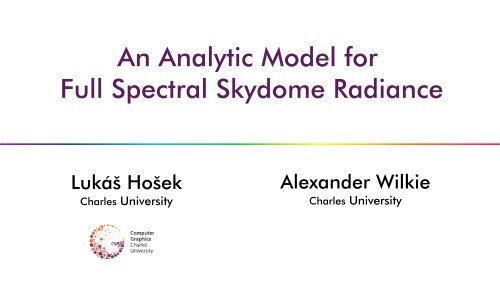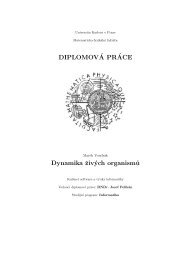SIGGRAPH 2012 presentation slides
SIGGRAPH 2012 presentation slides
SIGGRAPH 2012 presentation slides
Create successful ePaper yourself
Turn your PDF publications into a flip-book with our unique Google optimized e-Paper software.
An Analytic Model for<br />
Full Spectral Skydome Radiance<br />
Lukáš Hošek<br />
Charles University<br />
Alexander Wilkie<br />
Charles University
• outdoor scenes<br />
Motivation: Skydome models<br />
• prediction of material appearance<br />
• architecture, outdoor scenes<br />
• alternative: skyboxes
The Preetham Model<br />
• De facto standard analytic skydome model<br />
• Simple closed form formulas<br />
• Outputs tristimulus data, convertible to spectral<br />
• Perez formula, fitted to the outputs of Nishita model<br />
• Fitting results publicly available<br />
luma distribution parameters<br />
B/cos θ D 2<br />
<br />
F( θ, γ) = 1+Ae 1+ Ce γ + Ecos<br />
γ<br />
solar angle<br />
zenith angle
inputs<br />
once per scene<br />
The Preetham Model<br />
θ <br />
3<br />
S<br />
0.00166 -0.00375 0.00209 0<br />
2 <br />
2<br />
θS<br />
x z = T T 1<br />
<br />
-0.02903 0.06377 -0.03202 0.00394<br />
<br />
<br />
<br />
θ <br />
S<br />
0.11693 -0.21196 0.06052 0.25886<br />
<br />
<br />
1 <br />
F (θ,γ)<br />
A,B,C,D,E<br />
x = x z·<br />
F A,B,C,D,E (0,γ s)<br />
output zenith angles<br />
A 0.1787 -1.4630<br />
<br />
B<br />
<br />
-0.3554 0.4275<br />
<br />
T C = -0.0227 5.3251 <br />
1<br />
<br />
<br />
<br />
D<br />
<br />
0.1206 -2.5771<br />
<br />
<br />
E <br />
<br />
<br />
-0.0670 0.3703<br />
<br />
zenith luminance luma distribution parameters<br />
for each sample<br />
turbidity<br />
solar-zenith angle
Issues With the Preetham Model<br />
• Simple functions for calculating zenith luminance and<br />
luma distribution parameters<br />
• Only a small subset of possible atmospheric conditions<br />
can be captured<br />
• Lack of localised aureole at higher turbidities<br />
• Spectral data are obtained by conversion from trisitmulus<br />
data
Issues with the Preetham Model
• spectral (including UV)<br />
• larger range of turbidities<br />
• eliminate artifacts<br />
Goals for the New Model<br />
• ground albedo (came later & almost for free)
Obtaining Reference Data<br />
• Brute force Monte Carlo path tracer that incorporates<br />
• Mie scattering<br />
• Rayleigh scattering<br />
• Albedo & colour of Earth surface<br />
• Delta scattering<br />
• Approaches the simulation as a transport problem, the<br />
same way physicists simulate e.g. gamma rays passing<br />
through containment shells of nuclear reactors
Obtaining Reference Data
Result: Raw Data
Result: Comparison
χ(g,α) =<br />
Modified formulas for a better fit<br />
B/cos θ D 2<br />
<br />
F( θ, γ) = 1+ Ae 1+Ce γ + Ecos<br />
γ<br />
B 1<br />
<br />
cosθ+0. 01<br />
Eγ 2<br />
2<br />
F(θ, γ) = 1+ Ae · C+ De + F cos γ +G χ(H,γ) +I cos θ<br />
<br />
<br />
2<br />
1+cosα<br />
3<br />
2 2<br />
(1+g -2g·cos α)<br />
fudge factor to prevent<br />
divergence to infinity<br />
at zenith<br />
anisotropic term<br />
for luminance peaks<br />
around sun<br />
original Perez formula<br />
supresses luminance peak<br />
exending too far up<br />
modified formula
inputs<br />
Model flowchart<br />
once per scene<br />
for each sample<br />
x z = B M (η,α, T)<br />
r<br />
solar elevation<br />
albedo<br />
turbidity<br />
mean radiance radiance distribution parameters<br />
x = x ·F (θ,γ)<br />
z A, B, ,I<br />
output<br />
A <br />
<br />
B<br />
<br />
= B M (η,α, T)<br />
d <br />
<br />
I
How the Fitting was Done<br />
• Levenberg-Marquardt nonlinear optimization<br />
• Yields a mean radiance and radiance distribution array<br />
• These are then used as control points for Bezier<br />
interpolation<br />
• Albedo 0-1<br />
Turbidity 1-10<br />
Solar elevation 0-90°<br />
320nm – 720nm bands, 40nm increment
Results
Sky Colour Patterns (sunset)
UV & Fluorescence
Ground Albedo<br />
black white<br />
water blue forest green
Conclusion<br />
• Reference implementation and data available for<br />
download<br />
• Version 1.1 out!<br />
• http://cgg.mff.cuni.cz/projects/SkylightModelling/
















